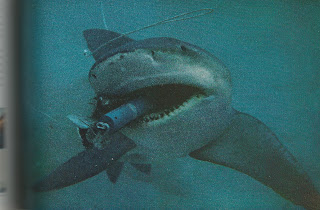Here's
More Science Fiction Tales (1974, edited by
Roger Elwood, illustrations by
Rod Ruth), a follow up to 1971's Science Fiction Tales (also edited by
Elwood and illustrated by
Ruth) and belonging to a series of hardcover children's horror/sci-fi anthology books published by Rand McNally in the
70s (I've previously posted on the Elwood-edited
Monster Tales and
Horror Tales, Ida Chittum's
Tales of Terror, and perhaps the most sought after entry,
Baleful Beasts and Eerie Creatures, also illustrated by
Ruth).
The full title is
More Science Fiction Tales, Crystal Creatures, Bird-Things, & Other Weirdies, seven tales of science fiction by seven authors, with an introduction by Barry N. Malzberg (full table of contents posted below).
Several of the stories here could rightfully be considered belonging to the horror genre, including my favorite,
A Hole In Jennifer's Room by Brian T. LoMedico.
Fourth-grader Jennifer is awakened one evening by a glowing orb that materializes out of her bedroom wall. A creature that she describes as resembling a large chicken embryo emerges from the lit portal and begins stalking around her bedroom.
Frightened, Jennifer is about to attack the alien thing with a baseball bat when the creature suddenly introduces itself, speaking perfect English. Its name is Xander, and it is an inter-dimensional traveler that took a wrong turn and ended up in Jennifer's room in Dimension Three. At first it seems like the beginnings of a friendship between the unlikely pair is starting to emerge, until Xander decides to explore the rest of the house on his own and is never seen again.
Jennifer's parents don't believe her story and she is forced to see a doctor who prescribes pills to alleviate what they presume is a hallucinatory episode.
But the pills don't help, as Jennifer is continually tormented by the sounds of Xander's clicking beak, and glimpses of movement caught in her peripheral vision. Xander, as it turns out, never really did leave Jennifer, as the final chilling paragraph reveals:
And sometimes, in the deep darkened corners of her mind, Jennifer heard a whispering voice, answering her as if from a great distance. It always said the same thing. "I'm right here, Jennifer. And remember, you did it all to yourself.... You should have hit me with that baseball bat."
...
In
The Bend of Time (William Danton), a boy returning to a recolonized Earth in the year 4010 is able to communicate across time with another boy his age from a prior millenium, when the world was ruled by robots called Ogolots.
In
Hide and Seek (Mario Martin Jr.), a boy looking for a fallen meteor encounters a friendly crashed alien who helps him defend the Earth from some not-so-friendly crab-like invaders.
The Music of Minox (Howard Goldsmith) finds an interplanetary mining camp attacked by aliens monsters resembling crystalline porcupines that emit harp-like sounds.
In
The Thing From Ennis Rock (Thomas F. Monteleone), a boy brings home a large egg found in the rubble following an earthquake and soon hatches a baby pteranodon. But mama pteranodon isn't giving up on her baby that easily. This story has a surprisingly dark ending.
A Thirst For Blood (Arthur Tofte), a story of vampires and interplanetary adventure set in the year 2040, opens with a boy being forced to carry out the grim ritual of decapitating the corpse of his father to cancel a vampiric curse.
Finally, a girl is temporarily transformed into a wolf by a mad scientist in
Werewolf Girl (Nic Andersson).




































































